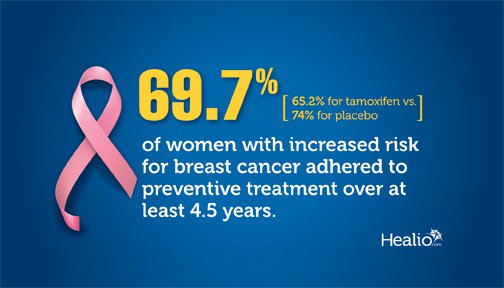Women who experience nausea, vomiting less adherent to preventive breast cancer therapy
Women who experienced predefined symptoms of adverse effects from preventive breast cancer drugs in the first 6 months of treatment appeared less likely to adhere to preventive therapy, according to findings from a randomized controlled trial.
However, study participants appeared to attribute age-related symptoms to cancer therapy.
“Preventive therapy is an option for women at increased risk [for] breast cancer resulting from known risk factors, such as having a family history of the disease,” Samuel George Smith, PhD, of the Leeds Institute of Health Sciences, U.K., and colleagues wrote. “Individual participant data from nine primary prevention trials showed a reduction of breast cancer incidence of at least 30% among women who used selective estrogen receptor modulators.”
However, only 16% of women opt to use chemoprevention; a major deterrent is concern about adverse events.
Smith and colleagues randomly assigned 3,823 women to either 20 mg of daily tamoxifen or placebo. The researchers calculated adherence based on information from six monthly clinical visits, and adjusted for age, smoking, hormone replacement therapy usage, menopausal status, baseline menopausal symptoms, treatment and age.
Most women adhered to preventive treatment for at least 4.5 years (69.7%; 65.2% for tamoxifen vs. 74% for placebo; P < .001).
The treatment arms showed differences in adherence beginning at 12 months and becoming largest at 54 months (all P < .001). The highest dropout rates occurred during the 12- to 18-month period, with rates decreasing after 18 months.
Women who reported vomiting and nausea appeared less likely to be adherent than those who did not; this occurred in both the tamoxifen (OR = 0.57; 95% CI, 0.37-0.86; P = .007) and placebo groups (OR = 0.58; 95% CI, 0.37-0.93; P = .023).
Links with adherence appeared with gynecologic symptoms in the tamoxifen arm (OR = 0.77; 95% CI, 0.62-0.97) and headaches in the placebo arm (OR = 0.62; 95% CI, 0.42-0.91).
The treatment groups showed similar effect sizes for each symptom on adherence (P > .05). Increasing severity of symptoms conferred lower adherence for all symptoms (P < .01) except headaches.
“These data from the International Breast Cancer Intervention Study-I breast cancer preventive therapy trial show that the effect of nausea/vomiting, headaches, hot flashes and gynecologic symptoms on adherence was similar between tamoxifen and placebo arms, suggesting that women are attributing nonmedication-related bodily changes to preventive therapy,” the researchers wrote. “Intervention strategies are needed to promote adherence, as well as to effectively communicate the harms and benefits of preventive therapy to participants.” – by Andy Polhamus
Disclosure: Smith reports no relevant financial disclosures. Please see the full study for a list of all other researchers’ relevant financial disclosures.

